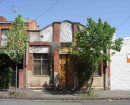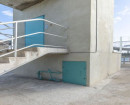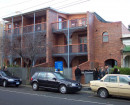Seymour Army Hut
Tallarook Street, SEYMOUR VIC 3660
-
Add to tour
You must log in to do that.
-
Share
-
Shortlist place
You must log in to do that.
- Download report
Statement of Significance
The Seymour Old Town Precinct is an area that has been affected by every stage of the development of the town from interaction with the Taungurung people by the early European settlers to the most recent development. It provides important examples of many of the themes identified in the Environmental History including: exploration and settlement; adapting to diverse environment; infrastructure of original town; river crossings; accommodation and services for travellers; public services, as well as cultural and social life. Overall, the most important themes represented in the existing physical fabric are those from the Victorian period 1839 to 1900 and to a lesser extent, the early part of the twentieth century.
The Seymour Old Town Precinct is historically significant at the LOCAL level (AHC criteria A.4).
The collection of the primarily 19th century public, commercial, religious and domestic buildings demonstrate the establishment of Seymour's original centre at the New Crossing Place, and its importance as Seymour's town centre prior to the coming of the railway and the establishment of an alternative commercial centre next to the railway station on higher ground less liable to flooding. The hotels testify to the importance of the old Seymour centre as a service point for travellers between Melbourne and Northern and North-eastern Victoria and New South Wales. The proximity of the centre to the river and riparian river re gum woodland is not only important to understanding the reason for its existence but also to its demise as the retail centre for the town which was partly due to its flood prone location. The whole area including that area north of the river covers part of the early settlement and may be significant for archaeological remains of the Seymour Hotel and other structures dating back to before 1855.
The precinct is aesthetically significant at the LOCAL level (AHC Criterion E.1).
The historic buildings, all single or two storey in height, provide an important view of authentic historic architecture and fabric in their historic urban design setting, some with mature exotic trees. The Slot views from Edwards Street to the historic buildings and woodland beyond and the views of the mature exotic trees from Ballendella Place are important.
The historic buildings visually connected to the five way intersection, in Emily Street Tallarook and High Streets, form a relatively compact grouping from which it is possible to sense the visual character of the 19 century town centre. Views to riverside bush down Manners Street and Robert Street and the visual incursion of that woodland into the parkland at Robert Street reinforce the northern edge of the country town. Further, these trees provide an important aesthetic and historic setting for the historic structures in this precinct.
The swail drains formed along the graded roads and those with asphalt down the centre of the road reserve, provide an important visual setting for the historic character of this precinct.
The precinct is scientifically significant at the STATE level (Heritage Victoria Criterion C The place or object's potential to educate, illustrate or provide further scientific investigation in relation to Victoria's cultural heritage ). The whole area is important as it covers the scene of early European interaction with the Taungurung people and is one of the earliest and most important crossing places along the route from Sydney to Melbourne. However, those sites that relate to the sites marked on the early maps are of most interest. These include the original tracks, ford, punts, hotels, houses, churches, graveyard and shops and their surrounding land.
Overall, the Seymour Old Town precinct is culturally significant at the LOCAL level.
Sourced by Lorraine Huddle P/L 2006
-
-
Seymour Army Hut - Physical Description 2
Building, Public
Seymour Army Hut - Physical Description 1
'Pioneer' Library. Established 1875. Brick building with corrugated iron roof. (see also record 912 - same place?)
The majority of the historic buildings face Emily Street, as it follows the line of the historic track, and later, the Hume Highway, from Melbourne to Sydney. These buildings range in size from small buildings to 2 storey grander buildings, all with hip and/or gable rooves, clad with slate or corrugated iron. Picturesque skyline features such as decorative parapets, or chimneys adorn the roofs. The architectural styles are primarily Victorian with some early Federation/Edwardian buildings, mostly constructed in stone or brick, with some clad and constructed in timber such as early vernacular structures eg. 'Guild's' store, Royal Hotel stables and log lock-up.
Along the north side of Emily Street the buildings are located along the street boundary - but everywhere else the front, and side setbacks vary.Seymour Army Hut - Historical Australian Themes
6.1 Forming associations, libraries and institutes for self-education
Veterans Description for Public
Seymour Army Hut - Veterans Description for Public
The Former Mechanics Institute and Free Library, located on Tallarook Street, Seymour, was built in 1875. In the post-Second World War period, an iron Army Hut was attached to the brick facade rear on Edwards St.
Heritage Study and Grading
Mitchell - Mitchell Shire Heritage Study
Author: Lorraine Huddle Pty Ltd
Year: 2006
Grading: Local
-
-
-
-
-
SEYMOUR RAILWAY STATION
 Victorian Heritage Register H1591
Victorian Heritage Register H1591 -
SEYMOUR ROTARY PARK PILINGS
 Victorian Heritage Inventory
Victorian Heritage Inventory -
Former Court House
 National Trust
National Trust
-
'Boonderoo', House and Outbuildings
 Greater Bendigo City
Greater Bendigo City -
'Riverslea' house
 Greater Bendigo City
Greater Bendigo City -
1 Adam Street
 Yarra City
Yarra City
-
-











